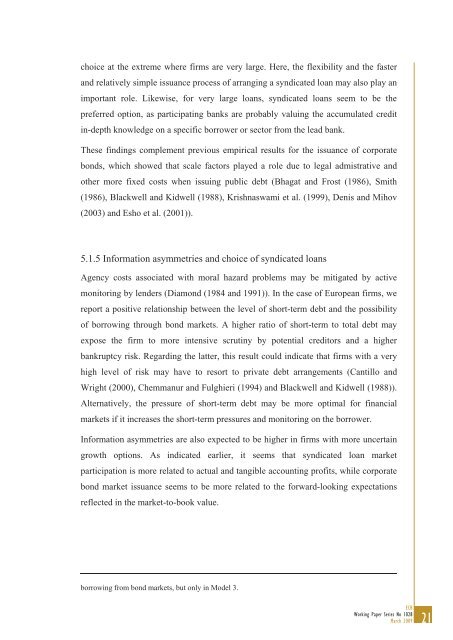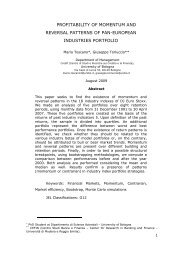large debt financing syndicated loans versus corporate bonds
large debt financing syndicated loans versus corporate bonds
large debt financing syndicated loans versus corporate bonds
Create successful ePaper yourself
Turn your PDF publications into a flip-book with our unique Google optimized e-Paper software.
choice at the extreme where firms are very <strong>large</strong>. Here, the flexibility and the faster<br />
and relatively simple issuance process of arranging a <strong>syndicated</strong> loan may also play an<br />
important role. Likewise, for very <strong>large</strong> <strong>loans</strong>, <strong>syndicated</strong> <strong>loans</strong> seem to be the<br />
preferred option, as participating banks are probably valuing the accumulated credit<br />
in-depth knowledge on a specific borrower or sector from the lead bank.<br />
These findings complement previous empirical results for the issuance of <strong>corporate</strong><br />
<strong>bonds</strong>, which showed that scale factors played a role due to legal admistrative and<br />
other more fixed costs when issuing public <strong>debt</strong> (Bhagat and Frost (1986), Smith<br />
(1986), Blackwell and Kidwell (1988), Krishnaswami et al. (1999), Denis and Mihov<br />
(2003) and Esho et al. (2001)).<br />
5.1.5 Information asymmetries and choice of <strong>syndicated</strong> <strong>loans</strong><br />
Agency costs associated with moral hazard problems may be mitigated by active<br />
monitoring by lenders (Diamond (1984 and 1991)). In the case of European firms, we<br />
report a positive relationship between the level of short-term <strong>debt</strong> and the possibility<br />
of borrowing through bond markets. A higher ratio of short-term to total <strong>debt</strong> may<br />
expose the firm to more intensive scrutiny by potential creditors and a higher<br />
bankruptcy risk. Regarding the latter, this result could indicate that firms with a very<br />
high level of risk may have to resort to private <strong>debt</strong> arrangements (Cantillo and<br />
Wright (2000), Chemmanur and Fulghieri (1994) and Blackwell and Kidwell (1988)).<br />
Alternatively, the pressure of short-term <strong>debt</strong> may be more optimal for financial<br />
markets if it increases the short-term pressures and monitoring on the borrower.<br />
Information asymmetries are also expected to be higher in firms with more uncertain<br />
growth options. As indicated earlier, it seems that <strong>syndicated</strong> loan market<br />
participation is more related to actual and tangible accounting profits, while <strong>corporate</strong><br />
bond market issuance seems to be more related to the forward-looking expectations<br />
reflected in the market-to-book value.<br />
borrowing from bond markets, but only in Model 3.<br />
ECB<br />
Working Paper Series No 1028<br />
March 2009<br />
21

















